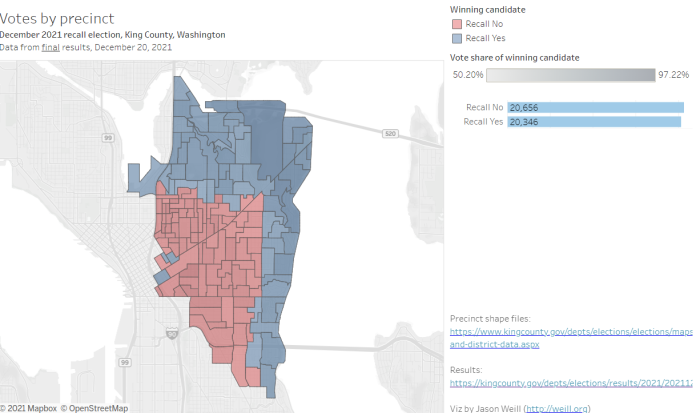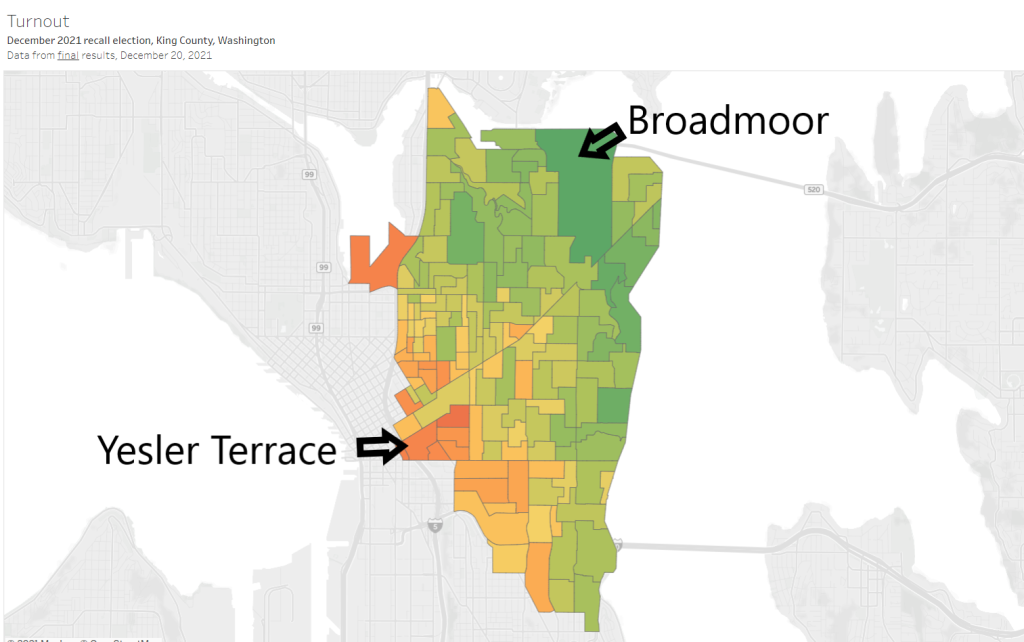
Apartment-heavy areas continue to see lower turnout rates, but enough voted to eke out a win for Sawant.
Earlier this month, Councilmember Kshama Sawant survived a recall election by 310 votes. Like her previous elections, Sawant’s strength was overwhelmingly in Capitol Hill and the Central District — formerly redlined areas which continue to be lower income and more racially diverse than the northern and eastern reaches of Council District 3.
Cartographer Jason Weill created a results map which shows that once again the E Republican Street wall held Capitol Hill voters south of Republican Street overwhelmingly favored Sawant, as did voters west of 32nd Avenue. The sole exception was one Miller Park precinct that dips south of Republican Street and did back recall (not a total surprise as this precinct also backed Bruce Harrell last month, while Nikkita Oliver and Nicole Thomas-Kennedy won by very narrow margins there.) It’s basically the same formula that has propelled Sawant to victory in her last three elections, albeit by slipping margins in her last two contests.
Politically, Sawant’s win — her fourth in eight years — guarantees another progressive vote on City Council while also deflating narratives that Seattle’s political fault lines were irrevocably shifted in centrists’ favor after Bruce Harrell decisive mayoral win in November. She will continue to be a firebrand for Leftists, a punching bag for centrists, and a thorn in many sides. (More on the political ramifications here.)
*
Turnout mostly followed the same pattern as the November election did. Single family zoned areas turned out in greater numbers that the denser apartment-heavy core of D3, as the turnout map via Weill embedded below shows. Young voters did turn out in the recall election a bit more than they did in November and composed the only age demographic with higher turnout than November, but not enough to remake the overall turnout map. Overall D3’s recall turnout was just shy of 53%, which wasn’t far behind the 54.6% citywide turnout in the mayoral election the previous month.
*
In a way it’s not surprising that the voting pattern is consistent. Sawant is an extremely well known figure after being on the ballot so frequently over her eight years in office, voters have largely formed an opinion about her one way or the other. City Councilmembers don’t typically get so much attention, but being basically the only revolutionary Marxist elected official in the country will tend to do that.
A Look Back at 2019 Turnout
Rich vs Poor
Councilmember Sawant regularly stresses that movement politics and a direct confrontation with the powers than be — whether corporations, billionaires, megadevelopers, political elites, and so forth. That may prove out in time, but for now the turnout map tells a little different tale. The most mobilized precinct of all in the recall election was the exclusive gated golf-adjacent community of Broadmoor with 78% turnout, a whopping 97% of them who favored recalling Sawant. Fifteen Broadmoor precinct residents opposed ousting Sawant — an interesting group of free thinkers.

Some of the lowest turnout rates, meanwhile, were registered in Yesler Terrace, a community with one of Seattle’s largest mixed-income social housing developments. The main Yesler Terrace precinct had 30% turnout and another precinct just to the east registered the lowest turnout of the election at 24%. In those two precincts 63% and 85% of voters, respectively, opposed the recall.
In battle of rich versus poor, the rich continue to outvote the poor, sometimes by a three-to-one advantage in turnout rate. It seems doubtful the socialist revolution envisioned by Sawant could ever happen if that continues to be the case.
Doug Trumm is publisher of The Urbanist. An Urbanist writer since 2015, he dreams of pedestrian streets, bus lanes, and a mass-timber building spree to end our housing crisis. He graduated from the Evans School of Public Policy and Governance at the University of Washington in 2019. He lives in Seattle's Fremont neighborhood and loves to explore the city by foot and by bike.

